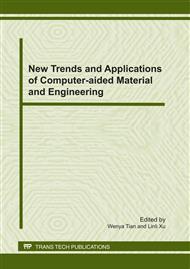[1]
B. C. Williams and P. Nayak, A model-based approach to reactive self-configuring systems, Proc. of the AAAI-96, pp.971-978(1996).
Google Scholar
[2]
P. J. Antsaklis, X. D. Koutsoukos and J. Zaytoon, On hybrid control of complex systems: A survey, European Journal of Automation, vol. 32(1998), pp.1023-1045.
Google Scholar
[3]
ZHAO Jian, OuYang Dan-tong. Research of Modeling the Hybrid System in MBD. JOURNAL OF GUANGXI NORMAL UNIVERSITY(NATURAL SCIENCE EDITION), 2008,26(2):1052-10.
Google Scholar
[4]
Lerner U , Parr R , Koller D , et al . Bayesian fault detection and diagnosis in dynamic systems. Proc. of the 17th National Conference on Artificial Intelligence ( AAAI) , Austin , Texas , 2000 : 531-537.
Google Scholar
[5]
P. J. Antsaklis, X. D. Koutsoukos, Hybrid systems: review and recent progress, T. Samad Editor: Software Enabled Control: Information Technology for Dynamical Systems, NY: Wiley-IEEE, pp.273-298, (2003).
DOI: 10.1002/047172288x.ch14
Google Scholar
[6]
Cassandras C. G., D.L. Pepyne (1997). Optimal control of a class of hybrid systems, in IEEE Conference on Decision and Control, San Diego, California, pp.133-138.
DOI: 10.1109/cdc.1997.650603
Google Scholar
[7]
M. Branicky, V. Borkar and S. Mitter, Unified framework for hybrid control: Model and optimal control theory, IEEE Trans. on Automatic Control, vol. 43, no. 1, pp.31-45, (1998).
DOI: 10.1109/9.654885
Google Scholar
[8]
Peng Z, Wang W H, Zhou D H. Diagnosis of Sensor and Actuator Faults of A Class of Hybrid Systems based on Semi-qualitative Method. Proc. of 2004 World Congress on Intelligent Control and Automation, Hangzhou, China, 2004: 14-18.
DOI: 10.1109/wcica.2004.1340977
Google Scholar
[9]
T. Koo, F. Hoffmann, H. Shim, B. Sinopoli and S. Sastry, Hybrid control of an autonomous helicopter, " IFAC Workshop on Motion Control, Grenoble, France, pp.285-290, (1998).
DOI: 10.1016/s1474-6670(17)40039-5
Google Scholar
[10]
R. Alur, C. Courcoubetis, T. A. Henzinger and P. -H. Ho, Hybrid automata: an algorithmic approach to the specication and verication of hybrid systems, "Hybrid Systems, vol. 736 of Lecture Notes in Computer Science, pp.209-229, Springer, (1993).
DOI: 10.1007/3-540-57318-6_30
Google Scholar
[11]
Reiter.R. A theory of diagnosis from first principles. Artificial Intelligence, 1987, 32(1): 57-96.
Google Scholar
[12]
Lynch N., R. Segala, F. Vaandrager, H. Weinberg, (1996). Hybrid I/O automata, Hybrid Systems III, no. 1066 in LNCS, pp.496-510, Springer Verlag.
DOI: 10.1007/bfb0020971
Google Scholar
[13]
S. Narasimhan, Model-based diagnosis of hybrid systems, Ph.D. dissertation, Dept. Electr. Eng. Comput. Sci., Vanderbilt Univ., Nashville, TN, (2002).
Google Scholar
[14]
George K. Fourlas, Multiple Faults Diagnosability Criteria in Hybrid Control Systems, in Proc. 20th International Workshop on Principles of Diagnosis DX2009, Stockholm, Sweden, 2009, pp.75-82.
Google Scholar
[15]
Cocquempot V., T. EI Mezyani, and M. Staroswiecki (2004). Fault detection and isolation for hybrid systems usingstructured parity residuals, Proc. of 5th Asian Control Conference, Melbourne, Australia, 1204-1212.
DOI: 10.1016/s1474-6670(17)36563-1
Google Scholar
[16]
R. J. Patton, P. M. Frank, and R. N. Clark, Issues of Fault Diagnosis for Dynamic Systems. London, U.K.: Springer-Verlag, (2000).
Google Scholar


